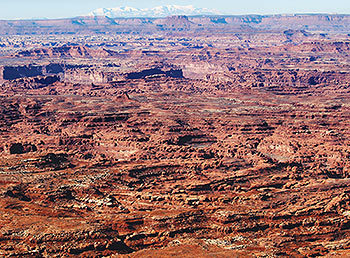 If a single word exists that describes the landscape around Moab (besides beautiful or inspiring), it would be its dominant color: red. Rocks exposed throughout canyon country are mostly one or more shade of red: dark red, maroon, brownish red, orange, reddish orange, pinkish red, and purple. If a single word exists that describes the landscape around Moab (besides beautiful or inspiring), it would be its dominant color: red. Rocks exposed throughout canyon country are mostly one or more shade of red: dark red, maroon, brownish red, orange, reddish orange, pinkish red, and purple.
These colors result from the presence of small amounts of iron oxide (essentially rust) in the rocks. Iron is not an element that is a major component of most sedimentary rocks, particularly sandstones which are chiefly made of quartz (SiO2) grains, although some clay minerals contain a fair amount of iron.
The reason that iron is responsible for coloring so many rock layers (formations to geologists) is that it is a common element in the crust and it is a very strong pigmenting agent. In fact, very little iron needs to be present to color a rock. Concentrations of iron oxide as low as a half a percent by weight are enough to color a sandstone red, particularly if it is present as thin films or coatings around sand grains or if it is part of the cement holding grains together.
The generic term that geologists use for red sedimentary rock layers is red beds. Red beds may be deposited in almost any environment, but more often on land (e.g., in continental environments) versus in bodies of water (e.g., in oceans—marine environments, or in lakes—lacustrine ones). Red beds found near Moab include the Moenkopi Formation that was deposited in tidal flats, river deltas, and floodplains, the Kayenta Formation that was deposited by rivers, and the Entrada Sandstone, one of the many eolian (deposited by wind in sand dunes) layers found in southeastern Utah.
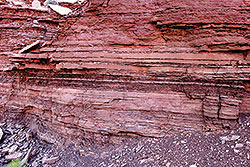 |
| Red beds in the Moenkopi Formation. |
The iron in red beds is present as the minerals hematite (iron oxide with the chemical formula of Fe2O3), limonite (iron oxide with some associated water), or goethite (iron oxide-hydroxide). Limonite is usually yellowish compared to the redder hematite, and goethite is brown.
The color of a sedimentary rock reflects both conditions when the sediment was being deposited, and those during diagenesis, the processes that occur as sediment changes into sedimentary rock.
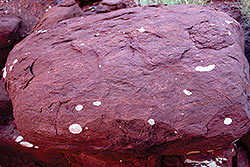 |
| “Polka dot” rock. Reduction spots in the Cutler Group. |
The sand found in most of the eolian layers found near Moab were red when they were deposited in ancient dunes as each grain had that hematite coating. The red color of many of the major sandstone layers found near Moab, such as the dark red Wingate Sandstone in the cliffs above Moab and along the Colorado River or the orangish red Entrada Sandstone in Arches National Park, reflect the reddish color of the dunes.
But other eolian sandstones, most notably the White Rim and Navajo sandstones, are off white. The White Rim Sandstone is found in Canyonlands National Park and the Navajo Sandstone is exposed throughout southern Utah including in Glen Canyon National Recreation Area, Capitol Reef National Park, and in many areas near Moab. Both these layers stand out in contrast to the reds in the layers above and below them. The iron oxide that had been present in these layers was removed during diagenesis by fluids that flowed through the deposits and bleached them.
Bleaching fluids may be petroleum (or other hydrocarbons) or weakly acidic water. They cause the iron to become reduced so that it gains an electron and becomes soluble. The iron is then carried away by the fluids, but may be precipitated again if oxygenated fluids are encountered. Sometimes the iron is only transported a short distance before it comes out of solution when it can sometimes form concentrated mineral masses called concretions. These concretions may have any shape, but spheroidal ones known as Moqui marbles are common in some bleached areas of the Navajo Sandstone.
As a general rule, layers that are easier for fluids to flow through are more likely to be bleached. The Navajo Sandstone is very porous leading to it being bleached in many areas. The White Rim is also porous, and contains a fair amount of petroleum as evidenced by the tar (elaterite) seeps found in it.
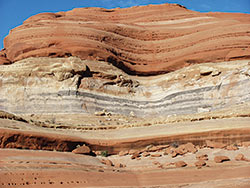 |
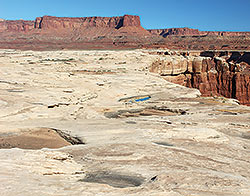 |
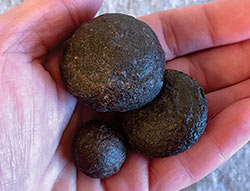 |
| Bleached Entrada Sandstone.jpg: A bleached zone (gray and yellow areas) in the Entrada Sandstone. The gray color caused by the presence of hydrocarbons. |
The White Rim Sandstone is white because it was bleached during diagenesis. |
Concretions like these Moqui marbles can contain around 15% iron oxide. |
Subtle differences in the characteristics of the sediment and fluid chemistry may cause iron to be removed from a red rock or be reprecipitated as concretions in an otherwise bleached sandstone. Sometimes only small bleached spots are present in an otherwise red rock where a speck of organic material caused localized reducing conditions. Or fine red and white laminations in a rock may result from there being slightly differences in porosity between them.
Whether it is on the scale of an entire mesa, a large outcrop, or even the small reduction spots in a “polka dot rock,” the dominance of red beds throughout canyon country along with the presence of white bleached sandstones show the essential role that iron plays in coloring the rocks, canyons, and cliffs surrounding Moab.
|